-
PDF
- Split View
-
Views
-
Cite
Cite
A de-la-Concha, U Dietrich, D Weigel, J A Campos-Ortega, Functional interactions of neurogenic genes of Drosophila melanogaster., Genetics, Volume 118, Issue 3, 1 March 1988, Pages 499–508, https://doi.org/10.1093/genetics/118.3.499
Close - Share Icon Share
Abstract
The neurogenic genes of Drosophila melanogaster are involved in the decision of ectodermal cells to take on a neural or an epidermal fate. We present evidence in support of the notion that six of the neurogenic genes are functionally related. We studied the phenotype of embryos lacking one of the neurogenic genes in the presence of an increased dosage of the wild-type allele of another neurogenic gene. Our analysis also included the Hairless locus, whose function is related to that of the neurogenic genes, as well as to many other genes. The effects observed were asymmetric in that triploidy for a given gene modified the phenotype of loss of the function of another gene, but triploidy of the latter gene did not modify the phenotype of loss of the function of the former gene. These asymmetries allowed us to establish a polarity of gene interactions, as well as to order the genes according to the assumed ability of some of them to modify the activity of others. In this sequence, almondex is the first link and Enhancer of split the last one. Our evidence suggests that the function of big brain is independent of the function of the other six. The consequences of this arrangement for the commitment of ectodermal cells are discussed.



